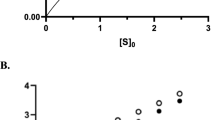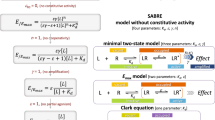Abstract
THE absence of a generally applicable pharmacological method for estimating the potency of potentiating compounds such as anticholinesterases and antiamine oxidases is perhaps partly a result of the accuracy with which these compounds can be assayed by manometric techniques on isolated enzymes. Inhibitory potency determined in this way, however, is not necessarily indicative of the potentiating activity to be found in the whole animal or even in isolated tissues.
This is a preview of subscription content, access via your institution
Access options
Subscribe to this journal
Receive 51 print issues and online access
$199.00 per year
only $3.90 per issue
Buy this article
- Purchase on Springer Link
- Instant access to full article PDF
Prices may be subject to local taxes which are calculated during checkout
Similar content being viewed by others
References
Schild, H. O., Brit. J. Pharmacol. Chemotherap., 2, 189 (1947).
Smith, C. M., Cohen, H. L., Pelikan, E. W., and Unna, K. R., J. Pharmacol. Exp. Therap., 105, 391 (1952).
Smith, C. M., Mead, J. C., and Unna, K. R., J. Pharmacol. Exp. Therap., 120, 215 (1957).
Edge, N. D., Arch. Intern. Pharmacodyn., 95, 428 (1953).
Quilliam, J. P., and Strong, F. G., Brit. J. Pharmacol. Chemotherap., 4, 168 (1949).
Author information
Authors and Affiliations
Rights and permissions
About this article
Cite this article
EDGE, N. pPy: a Measure of Potentiating Activity. Nature 216, 1014–1015 (1967). https://doi.org/10.1038/2161014a0
Received:
Revised:
Published:
Issue Date:
DOI: https://doi.org/10.1038/2161014a0
Comments
By submitting a comment you agree to abide by our Terms and Community Guidelines. If you find something abusive or that does not comply with our terms or guidelines please flag it as inappropriate.



